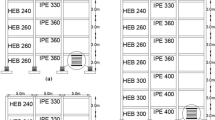Abstract
In this study, mechanical properties of lead core rubber bearing (LCRB) under variable pulse-like ground motions have been optimized to minimize the response quantities of interest at the level of the base isolation system, e.g., bearing acceleration and bearing displacement. Since the isolator period, effective damping ratio, superstructure mass, design displacement, and yielding displacement are major parameters that characterize the general behavior of the base isolation system, they have been selected as random variables. A single degree of seismically-isolated building as a shear beam-stick model has been implemented. Then, the dynamic response of the seismic isolation system is investigated considering the variability of mechanical properties of LCRB and superstructure mass over the base isolation system. In this investigation, the isolation device is developed using the Bouc–Wen model of hysteresis. To this end, Monte Carlo simulation has been conducted to provide comprehensive insight into the variability of seismic responses. Thus, 37,800 time-history analyzes have been performed and the effect of levels of uncertainty of the input parameters on the seismically isolated building's dynamic response is studied for 126 natural pulse-like ground motions whose pulse periods are between 0.6 and 13 s. Moreover, to find the best compound properties of LCRB parameters, the “desirability function optimization” method has been employed. Finally, the behavior of the LCRB has been optimized and increased its effectiveness to reduce the response criteria considering uncertainties in natural excitation parameters.













Similar content being viewed by others
References
Ahmadi, G. (1983). Stochastic earthquake response of structures on sliding foundation. International Journal of Engineering Science, 2(21), 93–102.
Alhan, C., & Gavin, H. (2005). Reliability of base-isolation for the protection of critical equipment from earthquake hazards. Engineering Structures, 9(27), 1435–1449.
Alhan, C., & Öncü-Davas, S. (2016). Performance limits of seismically isolated buildings under near-field earthquakes. Engineering Structures, 116, 83–94. https://doi.org/10.1016/j.engstruct.2016.02.043
Bagerzadeh Karimi, M. R. (2019). Seismic performance evaluation of the base isolation systems (Thesis). 1–200. Eastern Mediterranean University.
Cheng, F., Jiang, H., & Lou, K. (2008). Smart structures innovative systems for seismic response control. CRC Press Taylor & Francis Group. https://doi.org/10.1201/9781420008173
Chimamphant, S., & Kasai, K. (2016). Comparative response and performance of base-isolated and fixed-base structures. Earthquake Engineering & Structural Dynamics, 45(1), 5–27.
Dodson, B., Hammett, P., & Klerx, R. (2014). Probabilistic design for optimization and robustness for engineers. Wiley.
Elnashai, A., & Sarno, L. (2008). Fundamentals of earthquake engineering. Wiley.
Er, G. K., & Iu, V. P. (2000). Stochastic response of base-excited Coulomb oscillator. Journal of Sound and Vibration, 233, 81–92.
Eurocode8. (1998-1.). Eurocode 8, design of structures for earthquake resistance—Part 1: General rules, seismic actions and rules for buildings, EN.
Greco, R., & Marano, G. (2016). Robust optimization of base isolation devices under uncertain parameters. Journal of Vibration and Control, 22(3), 853–868.
Jacob, C., Sepahvand, K., Matsagar, V., & Marburg, S. (2013). Stochastic seismic response of base-isolated buildings. International Journal of Applied Mechanics, 1(5), 1–21.
Jangid, R. (2000). Stochastic seismic response of structures isolated by rolling rods. Engineering Structure, 8(22), 937–946.
Jangid, R., & Datta, T. (1995). Performance of base-isolation systems for asymmetric building subject to random excitation. Engineering Structure, 6(17), 443–454.
Kodakkal, A., Saha, S. K., Sepahvand, K., Matsagar, V. A., Duddeck, F., & Marburg, S. (2019). Uncertainties in dynamic response of buildings with non-linear baseisolators. Engineering Structures, 197, 109423.
Kohrangi, M., Vamvatsikos, D., & Bazzurro, P. (2018). Pulse-like versus non-pulse-like ground motion records: Spectral shape comparisons and record selection strategies. Earthquake Engineering & Structural Dynamics, 48(1), 46–64.
Kulkarni, J. A., & Jangid, R. S. (2002). Rigid body response of base-isolated structures. Journal of Structural Control, 9(3), 171–188. https://doi.org/10.1002/stc.11
Kulkarni, J., & Jangid, R. (2003). Effects of superstructure flexibility on the response of base isolated structures. Shock and Vibration, 10, 1–13.
Li, J., & Chen, J. (2004). Probability density evolution method for dynamic response analysis of structures with uncertain parameters. Computational Mechanics, 5(34), 400–409.
Masaeli, H., Khoshnoudian, F., & Tehrani, M. (2014). Rocking isolation of nonductile moderately tall buildings subjected to bidirectional near-fault ground motions. Engineering Structures. https://doi.org/10.1016/j.engstruct.2014.08.053
Minimum Design Loads for Buildings and Other Structures. (ASCE/SEI 7-10). American Society of Civil Engineers.
Montgomery, D. (2013). Design and analysis of experiments (8th ed.). Wiley.
Naeim, F., & Kelly, M. J. (1999). Design of seismic isolated structures: From theory to practice. Wiley.
Pan, P., Zamfirescu, D., Nakashima, M., Nakayasu, N., & Kashiwa, H. (2005). Base-isolation design practice in Japan: Introduction to the post-Kobe approach. Journal of Earthquake Engineering, 09(01), 147–171. https://doi.org/10.1142/S1363246905001943
PEER Ground Motion Database. (n.d.). Retrieved from Pacific Earthquake Engineering Research Center: https://ngawest2.berkeley.edu/
Technologies, W. (2010). Worksafe Technologies Corporation. Effects of seismic vibrations on disk drives. Retrieved September 03, 2010, from http://www.worksafetech.com/pages/isotest.html
Tyler, R., & Robinson, W. (1984). High-strain tests on lead–rubber bearings for earthquake loadings. Bulletin of New Zealand National Society Earthquake Engineering, 17(2), 90–105.
Xu, C., Chase, J. G., & Rodgers, G. W. (2014). Physical parameter identification of nonlinear base-isolated buildings using seismic response data. Computers & Structures, 145, 47–57. https://doi.org/10.1016/j.compstruc.2014.08.006
Yeh, C. H., & Wen, Y. K. (1990). Modeling of non-stationary ground motion and analysis of inelastic structural response. Structural Safety, 8(1), 281–298.
Author information
Authors and Affiliations
Corresponding author
Ethics declarations
Conflict of interest
The authors declare that there is no conflict of interests in this article.
Additional information
Publisher's Note
Springer Nature remains neutral with regard to jurisdictional claims in published maps and institutional affiliations.
Supplementary Information
Below is the link to the electronic supplementary material.
Rights and permissions
Springer Nature or its licensor (e.g. a society or other partner) holds exclusive rights to this article under a publishing agreement with the author(s) or other rightsholder(s); author self-archiving of the accepted manuscript version of this article is solely governed by the terms of such publishing agreement and applicable law.
About this article
Cite this article
Bagerzadeh Karimi, M.R. Optimum Values of Mechanical Properties for Lead Core Rubber Bearing (LCRB) Under Variable Pulse-Like Ground Motions. Int J Steel Struct 23, 780–794 (2023). https://doi.org/10.1007/s13296-023-00728-0
Received:
Accepted:
Published:
Issue Date:
DOI: https://doi.org/10.1007/s13296-023-00728-0




